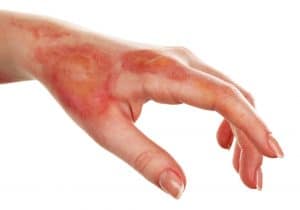 One of the worst injuries one could ever suffer from is a burn. Whether it’s from a fire, a hot and boiling liquid, a chemical, electric wiring, or just plain sun overexposure—a burn can really hurt so bad that you can faint from it, and it can even lead to death. The reason why burns hurt so much is that when your skin is exposed to a massive amount of inflammation, it causes the release of cytokines and prostaglandins—the nerve endings hypersensitive to pain. Unfortunately, the burning sensation and inflammation won’t be resolved until the pain persists.
One of the worst injuries one could ever suffer from is a burn. Whether it’s from a fire, a hot and boiling liquid, a chemical, electric wiring, or just plain sun overexposure—a burn can really hurt so bad that you can faint from it, and it can even lead to death. The reason why burns hurt so much is that when your skin is exposed to a massive amount of inflammation, it causes the release of cytokines and prostaglandins—the nerve endings hypersensitive to pain. Unfortunately, the burning sensation and inflammation won’t be resolved until the pain persists.
However, if you find yourself in the unfortunate incident of having to nurse a scalding burn, we have rounded up the factors that you should consider if you have been seriously burnt and what steps to take to help the injury heal faster.
First-degree burn
A first-degree burn only affects the epidermis which is the outer layer of your skin. However, it can still be painful. What you may see may only be slight redness with minimal skin damage but it can be hypersensitive to any touch. However, it is also the fastest type of burn to heal as you will begin to see an improvement in your skin within 7-10 days.
Do’s
- Soothe the burning sensation by exposing the burned area under running water for a full 5 minutes to cool off the heat in that specific area.
- Apply the gel of organic and fresh aloe vera. It has natural anti-inflammatory properties that can help speed up the healing process and reduce the redness.
- You can take mild pain relievers if the pain is too bothering.
Don’ts
- Do not apply ice as it can only worsen the damage by exposing the skin to a sudden change of temperature.
- Do not apply toothpaste as it has certain chemicals that can irritate the skin and only cause more redness and delay the healing process.
Second Degree Burn
The second-degree burn is the beginning of a more serious type of skin damage as it affects not only the epidermis but also the dermis. This means you are prone to having blisters and extremely painful areas of your skin. This type of skin damage can take up to 3 weeks to fully heal.
Do’s:
- Place the burned area under running water for 15 minutes to cool off the heat
- Apply a burn ointment to the affected area
- Apply a clean bandage that won’t shed any fibers, and replace it every day
Don’ts:
- Do not pop the blister as it may only expose the wound to bacteria which then can be a cause of an infection
- Do not clean the area using a cotton. The cotton fibers might stick to the wound and can cause an infection
Third-degree burn
 Aside from a fourth-degree burn, third-degree burn is the most severe type as it does not only damage your skin but your muscle tissues as well. It can inflict so much damage on your body that at some point, you won’t feel any pain anymore because of the severity of the nerve damage.
Aside from a fourth-degree burn, third-degree burn is the most severe type as it does not only damage your skin but your muscle tissues as well. It can inflict so much damage on your body that at some point, you won’t feel any pain anymore because of the severity of the nerve damage.
Do’s:
- Call 911 immediately so that help will be on the way as you perform first-aid
- Elevate the burned area to a level that is above your heart
- Keep the burned area off of any material, especially clothing that can leave fibers in the muscle tissue
Don’ts:
- Don’t put ice on the burned area
- Be careful not to waste any time. Ask for help especially for someone who can drive you to the nearest hospital so you can get immediate treatment
A third-degree burn can cause extreme permanent damage to your skin and can take at least 3 weeks for it to heal. One of the most obvious types is severe scarring which can manifest in hyperpigmentation.
Surely, no one is prepared for a serious burn injury and we can only do so much to fix the damage with whatever resources are available. However, it can also help if you learn to be more careful around objects that can cause severe burns such as chemicals, as well as wet and dry heat. If you want to look into the legal implications of getting yourself burn injuries, you can click here to get more information.
Recent Posts
- Castor Oil For Better Hair Growth: Is It Myth Or Fact?
- Exploring the Differences Between Sermorelin, Ipamorelin, Ibutamoren, GHRP2, and GHRP6: Understanding Their Role in Human Growth Hormone Regulation
- Unraveling the Mystery: Understanding the Causes and Prognosis of Ventricular Tachycardia Without Apparent Heart Disease
- Understanding Grandparents’ Rights in Oklahoma: Navigating Visitation and Legal Protections
- 10 Reasons to Consider Hypnotherapy for Your Health

